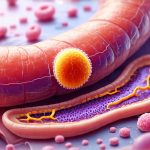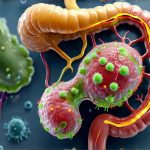The intricate relationship between our gut microbiome – the trillions of bacteria, fungi, viruses, and other microorganisms residing in our digestive tract – and overall health is increasingly recognized as pivotal. For decades, cardiovascular disease (CVD) was largely attributed to traditional risk factors like genetics, diet, smoking, and lack of exercise. However, emerging research powerfully demonstrates that the gut microbiome plays a significant, often underestimated, role in regulating key aspects of cardiovascular health, including blood pressure, cholesterol metabolism, and vascular function. This isn’t merely about what we eat, but also how our bodies process it – and a large part of that processing happens thanks to the microscopic ecosystem within us. Understanding this interplay opens exciting avenues for preventative strategies and novel therapeutic interventions.
This complex network isn’t a one-way street; it’s bidirectional. What we consume profoundly impacts the composition of our gut microbiota, and in turn, these microbial communities influence physiological processes extending far beyond digestion. Dysbiosis – an imbalance in the gut microbiome – has been linked to numerous chronic diseases, including hypertension, hyperlipidemia (high cholesterol), atherosclerosis (hardening of the arteries), and ultimately, CVD. The mechanisms through which the gut microbiome exerts its influence are diverse, involving metabolites produced by bacteria, immune system modulation, and even direct interactions with the nervous system. It’s a fascinating area of scientific discovery that continues to unravel new layers of complexity. Understanding gut inflammation affects energy can also help understand this complex interplay.
Gut Microbiota & Blood Pressure Regulation
The connection between the gut microbiome and blood pressure is multifaceted and surprisingly strong. For years, scientists believed hypertension was solely dependent on renal (kidney) function and hormonal regulation. Now we know it’s far more nuanced. The gut microbiota impacts blood pressure via several key mechanisms, including production of short-chain fatty acids (SCFAs), modulation of the renin-angiotensin system (RAS), and influence over inflammation. SCFAs – acetate, propionate, and butyrate – are produced when gut bacteria ferment dietary fiber. These aren’t just waste products; they’re powerful signaling molecules that can affect blood pressure directly. For example, butyrate has been shown to improve endothelial function, the health of the inner lining of blood vessels, contributing to vasodilation (widening of blood vessels) and reduced blood pressure.
The renin-angiotensin system is a hormonal pathway crucial for regulating blood pressure and fluid balance. Interestingly, certain gut bacteria can metabolize dietary nitrate into nitrite, which then converts to nitric oxide (NO). NO is a potent vasodilator – it relaxes blood vessels, lowering blood pressure. A healthy microbiome rich in nitrate-reducing bacteria therefore supports NO production. Conversely, dysbiosis can disrupt this process and contribute to hypertension. Furthermore, an unhealthy gut barrier allows bacterial components like lipopolysaccharide (LPS) to “leak” into the bloodstream, triggering chronic inflammation – a major driver of high blood pressure. Considering how to balance gut acidity can also help manage these processes.
The composition of your gut microbiome matters enormously. Studies have shown that individuals with hypertension often exhibit lower microbial diversity and specific alterations in bacterial populations. For example, reduced abundance of Bifidobacterium and Lactobacillus species has been observed in hypertensive patients. Conversely, enrichment of certain pro-inflammatory bacteria can exacerbate blood pressure issues. Therefore, strategies to modulate the gut microbiome – through diet, probiotics, or prebiotics – are increasingly being explored as potential adjunct therapies for hypertension management. It may be useful to look at simple breakfast options as a starting point for dietary changes.
Microbial Metabolites & Vascular Health
Microbial metabolites aren’t limited to SCFAs and NO precursors. The gut microbiota produces a wide array of compounds that directly influence vascular health. Trimethylamine N-oxide (TMAO), produced when bacteria metabolize choline, betaine, and L-carnitine found in red meat and eggs, has garnered significant attention. Elevated TMAO levels are strongly associated with an increased risk of atherosclerosis – the buildup of plaque in arteries. It appears to promote foam cell formation (a key step in plaque development) and impair cholesterol efflux (removing cholesterol from arteries).
However, it’s crucial to note that the relationship between TMAO and CVD is complex. Some research suggests that not all individuals respond to dietary choline or carnitine with increased TMAO production, highlighting the role of individual microbiome composition. Furthermore, gut bacteria can also metabolize TMAO into trimethylamine (TMA), which is then detoxified by the liver. A healthy liver and a balanced microbiome are therefore essential for mitigating the potential risks associated with TMAO.
Beyond TMAO, other microbial metabolites – such as indoles and phenols produced from tryptophan metabolism – have been shown to possess antioxidant and anti-inflammatory properties, protecting against vascular damage. The gut microbiota’s ability to transform dietary compounds into biologically active molecules underscores its profound impact on cardiovascular health. This metabolic capacity is a key reason why focusing on diet – specifically fiber intake – can be so beneficial. Understanding fermented foods and their effect on the microbiome is also important here.
The Gut-Brain Axis & Blood Pressure Control
The connection between the gut and the brain, known as the gut-brain axis, plays a surprising role in blood pressure regulation. This bidirectional communication pathway involves neural, hormonal, and immunological signaling. Stress, anxiety, and depression are all well-established risk factors for hypertension – and these conditions can significantly impact the composition of the gut microbiome. Chronic stress often leads to dysbiosis, further exacerbating inflammation and disrupting blood pressure control.
Conversely, a healthy gut microbiome can modulate brain function through several mechanisms. SCFAs produced by gut bacteria can cross the blood-brain barrier and directly influence neuronal activity. Furthermore, the gut microbiota influences the hypothalamic-pituitary-adrenal (HPA) axis – the body’s primary stress response system. A balanced microbiome can help dampen HPA axis activation, reducing cortisol levels and promoting a sense of calm.
This interplay highlights the importance of addressing mental well-being alongside dietary interventions when managing blood pressure. Practices like mindfulness, yoga, and meditation – which promote relaxation and reduce stress – may indirectly benefit cardiovascular health by positively influencing the gut microbiome and the gut-brain axis. It’s about holistic health, recognizing that physical and mental states are inextricably linked. Considering step-by-step strategies for stress reduction can be very beneficial.
Cholesterol Metabolism & The Gut Microbiota
The gut microbiota profoundly influences cholesterol metabolism in several ways. Traditionally, cholesterol levels were thought to be primarily determined by genetics and dietary intake of saturated fats. We now understand that the gut microbiome actively participates in both cholesterol absorption and its elimination from the body. Certain bacteria can directly assimilate cholesterol, reducing its absorption into the bloodstream. Others can convert cholesterol into coprostanol, an inactive form excreted in feces, effectively lowering circulating cholesterol levels.
Bile acids – produced by the liver to aid in fat digestion – are also heavily influenced by gut bacteria. The microbiome can modify bile acid structure and composition, impacting their reabsorption and ultimately influencing cholesterol homeostasis. Dysbiosis can disrupt this process, leading to increased cholesterol absorption and elevated blood lipid levels. Specifically, imbalances in bacterial communities involved in bile acid metabolism have been linked to hyperlipidemia – high cholesterol and triglycerides.
Moreover, the gut microbiome influences the production of lipoprotein particles – vehicles that transport cholesterol through the bloodstream. Alterations in microbial composition can affect the size and density of these lipoproteins, impacting their atherogenic potential (ability to contribute to atherosclerosis). For example, an increase in small, dense LDL particles is associated with a higher risk of CVD, and gut bacteria may play a role in their formation. The emerging field of “microbiome-targeted therapies” aims to manipulate the microbiome to improve cholesterol metabolism and reduce cardiovascular risk. Understanding digestive tests can provide valuable insight here.
It’s vital to remember that this information provides a general overview and shouldn’t be interpreted as medical advice. Consulting with healthcare professionals for personalized guidance is crucial.


















